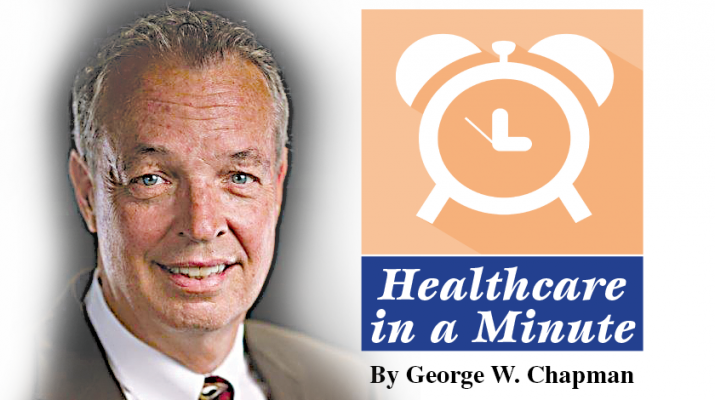By George W. Chapman
The collective term “advanced practitioner” refers to nurse practitioners and physician assistants. They are assuming an increasing role in the provision of care every year. It is projected that they will account for two-thirds of the new providers (MDs included) added to the workforce over the next decade. (It should be noted that the number of physicians entering the workforce is somewhat limited by the number of residency positions available.) The number of NPs/PAs per 100 MDs has been rapidly increasing since 2000 and will be 55/100 by 2030. The workforce projections for 2030 are about 1,076,000 MDs, 397,000 NPs and 184,000 PAs. The Association of American Medical Colleges continues to predict a shortage of 120,000 MDs by 2030. Many believe that is vastly overstated because the prediction doesn’t account/acknowledge the increase in the aforementioned advanced practitioners, technology, super drugs and artificial intelligence.
Genetic Testing
A recent article in the Wall Street Journal points to a huge gender gap in genetic testing. By a 3 to 1 margin, more women were tested for inherited gene mutation (like cancer) than men. Genetic counselors also report having far more women than men as clients. Experts have speculated: women are very concerned about breast cancer and more in tune with their health; men have historically been less likely to seek medical care; and men are less likely to embrace the results of genetic testing.
Employers Taking Charge
On average, employers cover two-thirds of an employee’s health premium. The rising cost of care has become an existential threat to the future of many businesses. The well-publicized joint effort by Amazon, Chase and Berkshire Hathaway to redesign how care is delivered and paid for has actually detracted from what is already happening with many employers who are increasingly taking matters into their own hands. More and more employers are contracting directly with narrow, high-performing provider networks to both shift and lower costs. Some companies are investing in primary care clinics and setting up preferred provider networks for their employees. Seventy percent of employers responding to a survey by the National Business Group believe a new entrant from outside the healthcare industry is necessary to really disrupt the unsustainable and unaffordable status quo protected by too many vested interests.
Hospital Ratings Conundrum
CMS established a “hospital compare” site so consumers can check a particular hospital’s ratings on measures such as mortality, safety, cost, timeliness of care, patient experience and readmissions. While this is all well and good, it begs the question: “What is one to do when a particular hospital rating is below average and that is where my physician admits?” This is becoming more of a dilemma as consumer choices are being limited by employers contracting with narrower networks, increased government incentives for hospitals and physicians to develop alliances; more physicians becoming employees of hospital systems; and insurance plans favoring particular hospitals. Going “out of network” is rarely a good option because you will lose your physician — and out of network co-pays are intentionally prohibitive. The best advice is to discuss your concerns and trepidations about a hospital with your physician. The physician may have an alternative for you. All hospitals are very concerned about their ratings and will take your concerns (and especially a physician’s concerns) seriously.
Med School Tuition-Free
The medical school debt students carry averages $200,000. This on top of their college debt. The other cost to consider: physicians don’t start earning money until their late 20s due to four years of medical school plus at least three years of residency. Magnanimously, the NYU school of medicine will begin to cover the cost of tuition regardless of the student’s financial situation. NYU is the first and only top 10 ranked medical school to do so. Incoming students this year will have all their tuition paid for and existing students will have the remainder of their tuition covered. Physicians are still No. 1 when it comes to income. According to a recent report from Glassdoor, the median base salary for physicians is $196,000, about 4 percent higher than 2017. NPs and PAs averaged about $108,000.
Controlling Drug Prices
The federal government regulates and determines what it will pay for physician and hospital services delivered to Medicare and Medicaid patients, government employees, and veterans. Most commercial payers tend to follow their lead and closely mirror those fees. The drug lobby has been particularly effective in avoiding government regulation of their fees and most agree the government should avail itself of its purchasing power (Medicare, Medicaid, VA, etc.) and get price concessions from drug manufacturers. In an effort to do just that, control Medicare Part D drug prices, CMS would give Medicare Advantage plans more flexibility in determining what drugs are on their formularies. It is called “indication based formulary design” and, obviously, cost would be an indication and consideration. But provider and patient advocacy groups are not happy with the Administration’s efforts to get Part D drug costs under control, which would eventually help commercial plans. The AMA argues this is a detriment to patients by introducing unfair complexity to Medicare patients and gives more power to insurers to decide on treatment plans. There is special concern about limiting the formulary for cancer treatment. It should be noted that physicians and hospitals received $8.4 billion in payments from drug companies in 2017 for research, “related expenses” and ownership and investment interests held by physicians and immediate family members.
George W. Chapman is a healthcare business consultant who works exclusively with physicians, hospitals and healthcare organizations. He operates GW Chapman Consulting based in Syracuse. Email him at gwc@gwchapmanconsulting.com.

